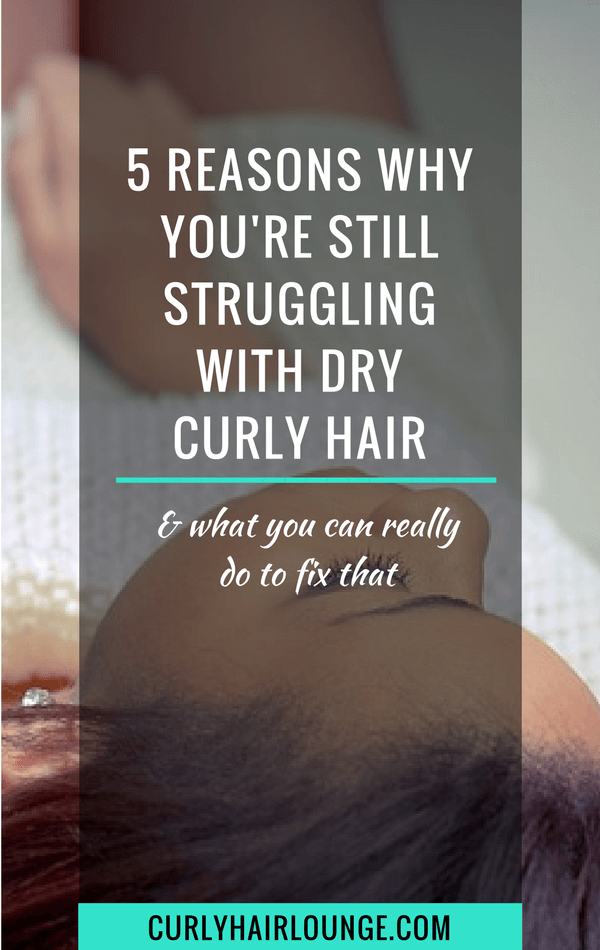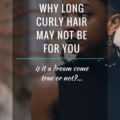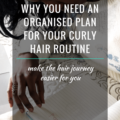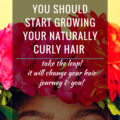It’s not strange to hear natural hair transitioners or naturals complain about how they can’t seem to keep their dry curly hair moisturised. These conversations are all over social media, blog post comments, YouTube videos, hair forums and so forth. Yes, when we talk about natural hair I have to say that most of what we do and talk about revolve around hair moisture. There’s no escaping it.
While moisturising your transitioning hair was seemingly an easy task to accomplish with relaxed hair, now while you’re transitioning to natural and your new hair texture is growing you may start to question “Why is my hair so hard to moisturise now?”.
Why are people still struggling with moisturising their hair?
I find that the real reasons behind this problem have yet to be addressed properly. Sure, you can find hints to solutions all over the place, something along the lines of “You need to use a water-based moisturiser!”, “Have you sealed your hair?” or “What about deep conditioning?”.
Don’t get me wrong, if you look in the right places you’ll find a great deal of good information out there, not just in here of course (eh eh eh 😉 )! It’s all useful, but why is it that people are still struggling with moisturising natural hair with so much info out there? Haven’t you asked yourself this same question?
Do you wanna know my two cents on the subject? Then keep reading…
5 Reasons Why You’re Still Struggling With Dry Curly Hair
#1| LACK OF KNOWLEDGE
Despite the sea of information, you can find on the web, some people still don’t know how to moisturise their hair. This is perfectly normal when you just started your hair journey whether you’re transitioning or going straight to the BC.
For many in here, including me, jumping onto this ride was a totally impulsive decision though I had been courting with the idea for some time. Much of the information I had was collected on YouTube, which despite being a big magnet to the natural hair community doesn’t always help us when it comes to taking care of our hair.
Relying on YouTuble vloggers to mimic hair practices, hair regimens and hair products doesn’t always (if at all) serve our hair needs, especially when no two heads of hair are the same, when people live in deferent parts of the world, have different diets, different health conditions and many other different variables.
What needs to be considered.
Though you can find good information out there, I believe many times people don’t know how to interpret and/or apply it all or they simply forget. Generally, people apply one, two or three concepts and others are forgotten or totally unknown.
Taking care of natural hair requires knowledge of curly hair in general (it’s characteristics) and in particular (your own hair). It requires you to know that:
- Porosity directly affects how your hair retains moisture and it is imperative that you know what yours is. It is also important you know porosity is affected by the use of heat, chemical treatments, excess moisture, sun exposure, chlorine or pH. It can be a lot to take in.
- Product build up also affects hair moisture. No, it’s not just products with synthetic ingredients that create build up. Natural ingredients also do the same over time. You should clarify your hair to remove build up. This should be done according to the ingredients in your hair products and how often you use them.
- Hard Water also affects your hair since the high concentration of minerals in it pile up on your hair and create a barrier making moisture intake difficult. Check the water quality in your area and clarify/chelate your hair accordingly.
- Excess protein will also leave your hair dry and will ultimately lead to hair breakage if unattended. Low porosity hair needs less protein, so you need to use it wisely or these adverse signs will show themselves swiftly. Check your products to see if you’re using too much protein. How do you know? Well, if it’s present across all or most of your hair products and is part of the first five in the ingredients list, you are overdoing. Check this post and this to know more about proteins. If you need more help you can grab this Curly Guide to Deep Conditioning.
#2| YOU CAN’T BE BOTHERED
Natural hair is like a rare flower in the middle of the desert, it needs attention and a lot of TLC. Many naturals have developed a multi-layered hair regimen to make sure their scalp and hair grow healthy and strong or healthy and long (Yeah, the lines get blurry here).
When I say people can’t be bothered, I don’t say it to offend or attack anyone. No, I am just pointing out that while I take duly care of my hair and devote a fair amount of my time to it, some people genuinely don’t want to do this because hair is not that important to them and they just want to grow their natural hair and have a fuss-free hair regimen.
However, because our hair requires more attention and hands-on work than when it was relaxed, some members of this hair community find such needs too demanding and either get lazy or skip pillar steps in their hair regimen such as deep conditioning or they simply don’t care about hair and manage it as problems arrive, never really preventing them (which is essential in any hair care routine and more so for curly hair).
Here’s how you can do better.
If you find yourself constantly struggling with dry hair and/or breakage and this “natural hair thing” is too much for you and you’d rather have things to be more simple, less time consuming but still be able to keep your curly tresses then maybe you should consider putting your hair in protective styles like braid or twist or maybe even apply hair extensions that are similar to your own hair texture.
No, you’re not lesser natural than me, you’re just doing what is best for your hair and what works for you! There’s no shaming here.
This option will still require you to take care of your hair but in a less demanding way (although maybe more expensive if you regularly visit a salon for this work). Just remember to keep your scalp and hair moisturised, to give your hair a break at least every 6 to 8 weeks, deep condition, do the occasional hair trim and don’t put too much stress on your scalp and hair, especially around your edges. Avoid thinning hair edges!

You can also take the opportunity to flirt with your curls when you have your break from hair from protective styling… know the saying “absence makes the heart grow fonder”. 😉
but…
If doing hair extensions are not really your thing or you find them too expensive, you should consider if natural hair really is for you. Maybe a short hairstyle (afro) would be better, less worrying… Consider, why is it that you decided to go natural in the first place? What is different now? What is better or worse? What do you like about your hair? How do you feel about it?… Do you feel anxious and excited about your hair and what comes along in your hair journey or do you feel apprehensive and disconnected?
Consider all this and decide if natural hair really is for you.
#3| HAIR PRODUCTS
A lot could be said about this and it has been said indeed. You can find here on the blog several posts calling attention to ingredients and how they can affect your hair. Such is the case of this post here that addresses ingredients that take moisture from your hair (silicones, mineral oil, sulphates and alcohol), this one that discusses the use shampoos or this one that alerts for the sole the use of washing conditioners to clean your hair.
The use of humectants also has an impact on your hair moisture. Ingredients such honey, panthenol, glycerin, propylene glycol or sorbitol are all great because they keep and attract moisture into your hair, however, if there’s no humidity in the hair it will take it from your hair and dry it out.
As said, previously, the excessive use of proteins in your hair products will also lead to dry hair. Fine hair is more fragile and can get strengthened with protein, but you also need to check your porosity. In the case of humectants and proteins, don’t forget to check their place in the ingredients list, the higher up the list the more impact they’ll have on your hair, the lower down the list the less. Did you check the deep conditioning guide?
All and all, many people know what I am saying here but don’t bother to read the list of ingredients on their products. Some are very poorly formulated and don’t have your hair’s interest at heart (only the cash), and by this, I’m not hinting out for you to adhere to the all-natural, 100% organic route.
No. It’s great if you do. But I understand that some brands are expensive and money can be tight. Also, there are some very good products out there that are not all-natural. Just make sure they are based on natural or naturally derived ingredients. Nevertheless, you don’t need to break the bank, I don’t! I occasionally make some of my hair products (flaxseed gel or hair butter) and it comes out to be very inexpensive. You can do the same, and the great thing is that you have total control over what is in your products. But I don’t advise you to have a full DIY product stash unless you know what you’re doing and know your hair is not missing out on important nutrition and care (most people don’t).
If you really don’t want to forge some bucks on natural hair products and you’re not the DIY kind of girl then you can go for cheaper brands, some are quite good. Many people use Tresemme (I loved the Naturals line, not so crazy about the Botanique line, though), Herbal Essences (used it, didn’t like it), Giovani (never tried it) and many others. The thing you’ll really have to look for is the list of ingredients, you may need to adjust or intensify some practices if it has some less desirable ingredients.
What do I mean by this? Well, you may consider doing weekly pre-poo to increase hair moisture instead of 1x a month.
#4| BEAUTY OVER HEALTH
Who doesn’t like to flaunt their beautiful hair and make everyone jealous when you’ve nailed the perfect twist out or wash and go? Oh, please we’ve all done it. It’s just that some flaunt their hair like they’re on a carousel ride while others are more poised. I personally do it more now than when I was relaxed (wayyy more, but always in a classy way of course 😀 ). Now I walk like a Queen, and so should you.
In any case, it is a fact that some are more focused on the end result than what it takes to get there.
What does this mean?
It means that to be able to showcase your beautiful hair it needs to be healthy. It needs to be moisturised, trimmed, deep conditioned, it needs low manipulation… you get the sermon, right? However, some bypass or make a blind eye to some of these practices and engage in damaging ones more often than advised.
Such is the case of chemical dye treatments (go natural, choose Henna) or the use of direct heat to achieve straight hairstyles. Others, may not engage in these specific behaviours but dismiss hair maintenance or important steps as deep conditioning. Experimenting with hair colour and styles is part of what being a woman is. Some like it more than others, but we all like to feel beautiful.
However, when you’re walking around flaunting your “beautiful” dry, dull, heat damaged hair, full of split ends and probably suffering from breakage, there is no beauty in this. If this is you, you need to acknowledge that our naturally curly hair needs a different approach.
If this is you, you need to accept the consequences of your actions and live with them while struggling to keep your hair moisturised, or you can take a different approach. A healthy one! Accept that You Are A Queen now and treat yourself (hair and all) like one.
Did you know you can still dye your hair safely with Henna? It’s totally natural and it has amazing benefits for your hair. A small warning, though. You won’t be able to dye your hair blond, for that you need to bleach your hair and that is a big blow on your tresses. You can also chemically alter your hair colour, but you need to be more hands-on with your hair care. Are you willing to do this?!
Heat can also be used. I’m not saying you have to chain that desire deep in your soul. No. However, you need to space that out (maybe 1 every 3 months) and use lower heat settings to avoid heat damage (loosening of your curls). You can check this post to learn how to avoid it and this one to choose your tools.
#5| HAIR REGIMEN
Lastly, but not less important is your hair regimen. Have you taken the time to make create yours? Don’t know how? Read this post, it will walk you through developing your first one, plus it has a handy worksheet to guide you and record your hair regimen. Alternatively, you can book a Shed & Rescue coaching call with me. Did you know I do hair regimen reviews or help you create your own?!

Why it is important to have one.
Having a hair regimen which defines how often you wash and/or co-wash your hair, when you trim or clarify your hair, what products you use, the hairstyles you prefer and so forth is very important. It may seem like a lot, but it gets easier as you get to know your hair and what it likes.
Once you have this set when you experiment with new things you’ll know what works best and what doesn’t. To make things easier I advise you to register things on a notebook. If this idea appeals to you, The Ultimate One-Year Natural Hair Journal may be what you need. I couldn’t find one that liked so I created one for me, you can check why here.
Still, you need to pay attention.
However, having a rigid hair routine can also be detrimental to your hair. If you see that something is not working you need to assess it, whether it is a product or a hair practice. A fair amount of people will witness changes in their hair (e.g. increased breakage/shedding) as the seasons change. Also, if a health condition arises and/or medication is needed or if you dye your hair and it gets dryer this means it needs extra TLC.
Seasons
For many people, their hair regimen needs to be adjusted during Winter and Summer, due to the extreme weather temperature that affects curly hair in a more noticeable way. Winter requires protecting your hair from the cold and dry temperatures that dry out curly hair because of the of lack humidity in the air (here’s another post you can read).
This season will be all about rich, heavy heavy products, protecting hair and scalp, doing protective hairstyles… in a nutshell making sure your hair is not dehydrated.
Summer, on the other hand, for many naturals will bring humidity which means frizzy hair. You should go for products with a lighter consistency that won’t weigh the hair down and using products and accessories to prevent sun damage as well as damage while pleasuring in the pool or beach. Also, make sure you’re not overdoing with humectants it can also be detrimental to your hair.
Don’t forget that during Summer and Winter people tend to be more exposed to the dry air of conditioned air or the thermostat at home, and this will also impact on your hair (read here for tools that will help with moisture).
Ingredients
Yes, I’m drilling it down again in case you weren’t paying attention! Ingredients Are Very Important!! Make sure, you’re not overdoing it with humectants, pulling too much moisture into your hair will make it swell creating frizz, which lifts the hair’s cuticle layers which can then easily break. This will leave holes in your hair structure making moisture retention difficult and you know what comes next…Dry Hair!
If this ever happens (God forbid, NO!), then you would need to adjust your hair regimen. How? By incorporating more protein to fix damages to hair structure and/or using sealing oils to lock moisture in, other things can also be considered.
The use of insoluble silicones will also create build up and shield your hair against moisture intake, making your hair dry. Make sure you remove it by clarifying your hair either with a regular sulphate shampoo or a clarifying shampoo, this one will also help to remove hard water minerals. Some people use clay (Rhassoul or Moroccan) or ACV. but I am not yet convinced on how effective they are.
Psst.
If you want an index list of soluble and insoluble silicones you can download this little resource by clicking below.
![]()
Wow, I guess I really had a lot to say about people struggling with dry curly hair and keeping their tresses moisturised. If this is a long post for you I am sorry, but this had to be said. I want you to reflect on everything and make some changes if you’re in this position.
Please read the links as they’ll take you to extra and more in-depth information. Hopefully, they’ll help you become more knowledgeable and actionable on your hair journey! Take your hair’s health under control.








